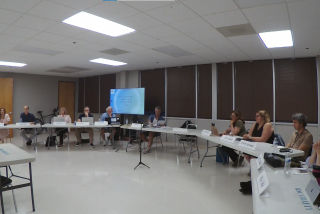There’s No Opting Out of Association
- Share via
QUESTION: We live in a group of 22 homes, the final phase of a homeowners association of 267 homes. Our phase was constructed by a different builder. Our homes were completed and brought into the association two years ago. All 22 are on a cul-de-sac. We would like to separate ourselves from the rest of the association. What is the procedure for breaking away?
ANSWER: You don’t have the right to opt out. You purchased a home in a community association, and you are obligated by the legal documents to remain a part of the association. The legal fees would be very expensive to even attempt to change the legal structure. All of the other 245 homes would be affected by any change in the total number of homes, so they would have to approve the separation.
If you read your legal documents and your annual budget, you will probably see that all 267 homes share the responsibility for maintaining all of the association’s common areas. The budget in many large associations includes the common expense of maintaining streets and street lighting, as well as swimming pools, green belts and other community assets and amenities.
If you don’t like the association or its rules, then your best option is to sell and move to a neighborhood that is not part of a community association. The cost of selling and moving will surely be less than the cost of your battle for independence.
Who Is Responsible for Repairs, Damages?
Q: A roof leak has caused substantial damage to the ceiling and walls of my unit. The association is in the midst of negotiations with the developer because of structural defects. The association is unwilling to make any permanent repairs until the case is settled. Now the developer is finally repairing the roof, but is not repairing the interior damage. Isn’t the developer responsible for my interior repairs also?
A: Yes, the developer should probably repair the interior damage, but you may have to take the right steps to protect yourself. If the association’s negotiations with the developer become protracted, you may have a long wait.
Contact your own insurance company to inquire about filing a claim. The insurance adjuster will probably want to review the association’s CC&Rs; to ascertain the party who is responsible for the drywall and ceiling repairs. Your insurance company may take care of your loss and subrogate against the developer’s insurance or the association’s insurance after it have paid your claim.
Board Refuses to Open Meetings to Members
Q: The board of directors of my community association refuses to allow the members to attend the board meetings. The directors have been informed about the law that requires open meetings, but they will not comply. What action can be taken? Can we withhold our monthly assessment?
A: You must continue to pay your monthly assessment and any other assessments that are levied by your association. Even if you think the leadership is despicable and unlawful, you cannot withhold your assessment. If you do, you may find that behind those closed doors, the board is voting to foreclose on your house or your unit because you failed to pay. Delinquency is not the way to force the board to change their errant ways.
Your board is putting all of the owners at risk by conducting closed meetings. Any of the owners could sue the board for failure to comply with the law. If the directors are willfully disregarding the law, they may find that their directors’ and officers’ insurance will not defend them.
Are other owners concerned about the board’s refusal to schedule open meetings? Perhaps a petition signed by many of the owners will convince them to change their ways. If the board ignores the petition, start planning to run for the board in the next election, and get others to assist you so that you can have a board that is controlled by people who will respect the law and respect the other owners’ right to be informed about the issues facing the association.
Bylaws Explain the Nominating Process
Q: Our homeowners association recently held its annual meeting. Before the meeting the president sent out a notice encouraging members to submit their names to the nominating committee. Another member and I submitted our names, but when the ballots were mailed out, our names were not listed. Only the two incumbents were named on the ballots. The president said we could be nominated at the meeting, but we did not receive enough votes. The people named on the mailed ballots obviously had an advantage.
The election was not an election, but rather an appointment of the incumbent directors, and although legal, it was not in the best interest of the homeowners.
A: Read your association’s bylaws to see how the nominating process is supposed to work. Some bylaws give the nominating committee a lot of power to determine the outcome of the election.
There are good reasons for having a nominating committee. For instance, a nominating committee can weed out the potential nominees who are delinquent in paying their assessments or those who are running for self-interest. If there are troublemakers who want to run, their divisive strategies can be very detrimental to the association.
I usually advise boards and management companies to get as many names as possible on the list of nominees. However, there are times when it is better to use a nominating committee and limit the number of nominees.
After you realized that your name was not on the election proxy, you could have campaigned by sending a notice to all of the owners about your candidacy. The association is obligated to give you the list of addresses or send a mailing for you at your expense so that you and others in the association can participate in the democratic process.
Board May Be Sued Over Loss of Tree
Q: When I moved into my condominium two years ago, I was elected to the board of directors and this year I am president. Serving on the board has been an interesting experience, but not always pleasant.
We have a difficult problem as a result of the removal of a tree. The board approved the pruning of several large trees that had been neglected for more than five years. Many of the trees had grown over the roof line so that leaves and debris were collecting on the roof and clogging the rain gutters.
Three of the five board members were present when we negotiated with the tree trimmer. We agreed that one large tree that was growing between two other very large trees should be removed. After the tree was cut down, the homeowner whose unit was directly under the tree threatened to sue the association.
The owner wants remuneration for the loss of the tree’s shade and the additional electricity expense for air-conditioning.
The board members felt that we were acting in good faith by protecting the roof and properly maintaining the trees. Now we are faced with the possibility of a lawsuit. What can we do?
A: The board can show that its action was taken to protect the association from roof damage, falling tree limbs and overgrowth of the trees.
The board has the authority to make decisions about the manner in which the association will maintain the property. The opinions of the owners should be respected, but sometimes trees have to be pruned or removed even though the individual owners don’t like the results.
Most judges in a court of law will not question the decisions of a board that acted in good faith. If you do end up in court, of course, no one can predict the actual outcome.
Obtain a statement from the tree trimmer regarding the reasons that the tree had to be removed. Send a copy to the unit owner and invite the owner to a board hearing.
I don’t believe that the association has any responsibility for the owner’s electricity. It would be difficult to determine a dollar amount since temperatures and the need for air-conditioning vary so much each year.
*
Hickenbottom is a past president of the Greater Los Angeles chapter of the Community Assns. Institute. She welcomes readers’ questions, but cannot answer them individually. Readers with questions or comments can write to her in care of “Condo Q&A;,” P.O. Box 5068, Thousand Oaks, CA 91360.


